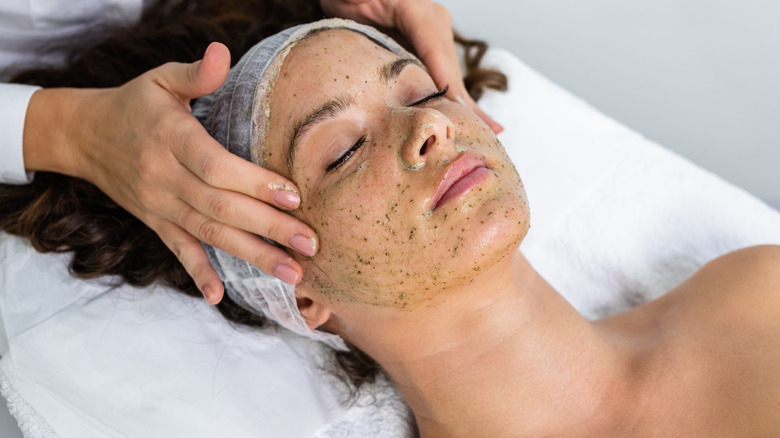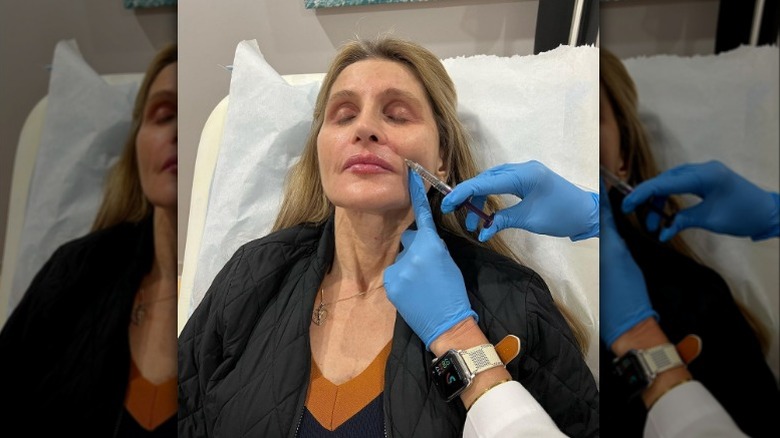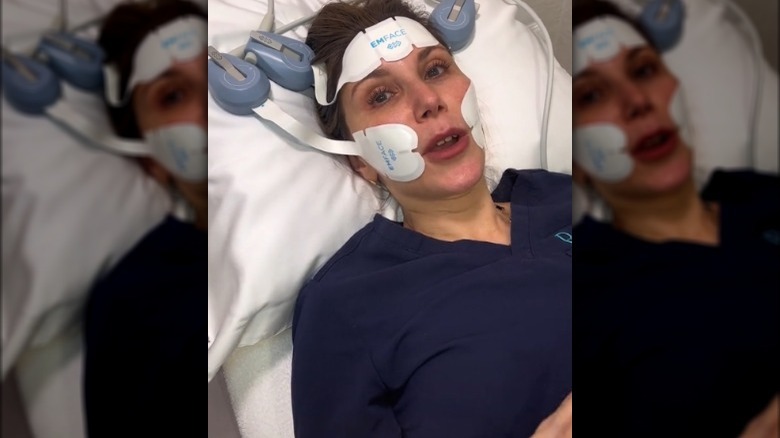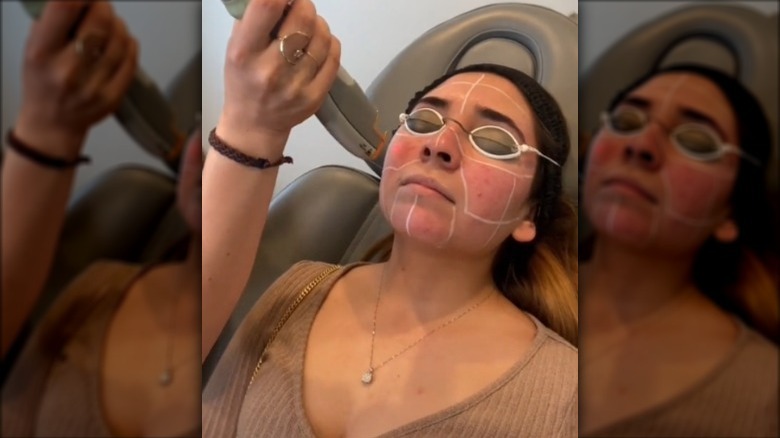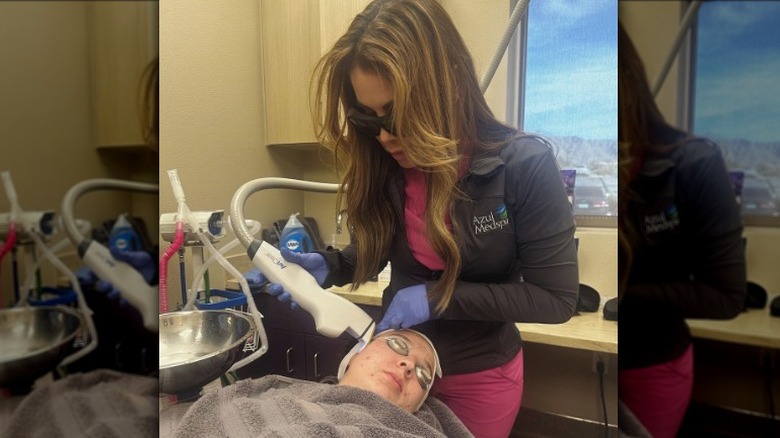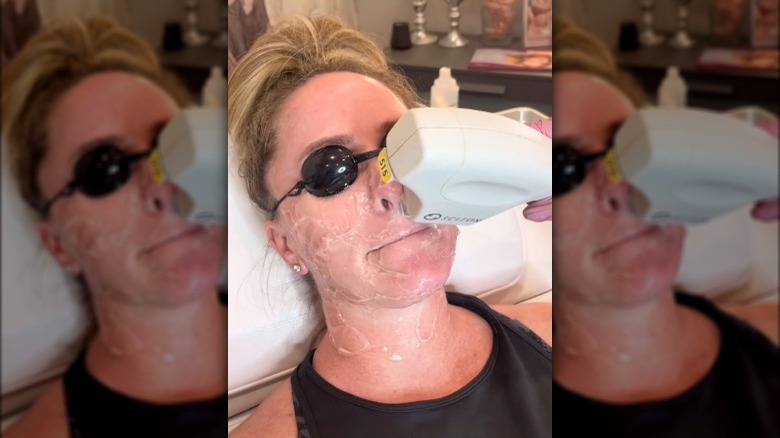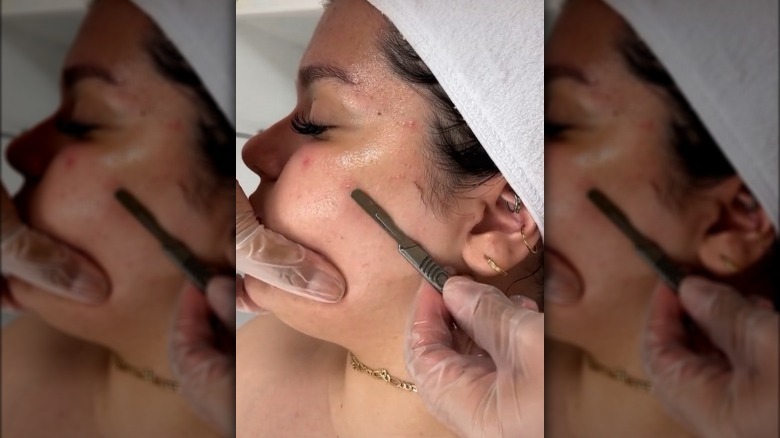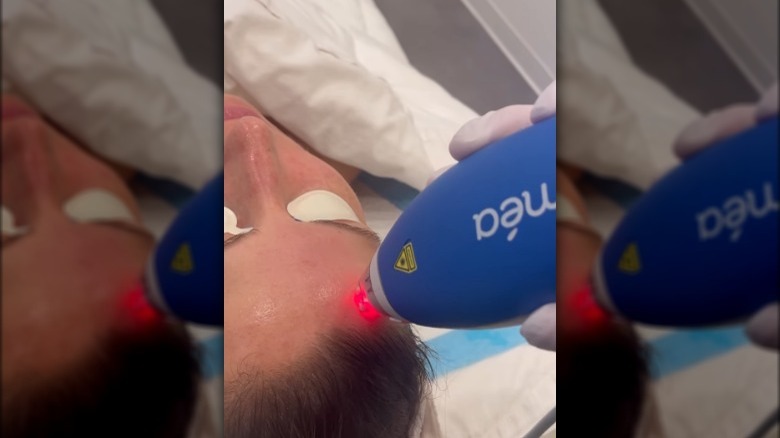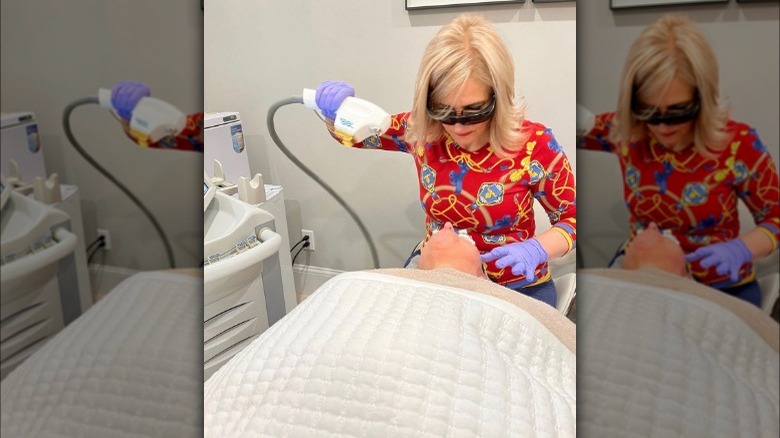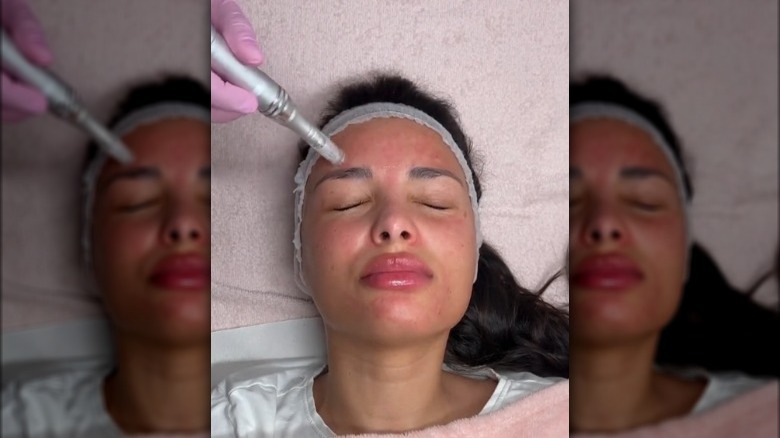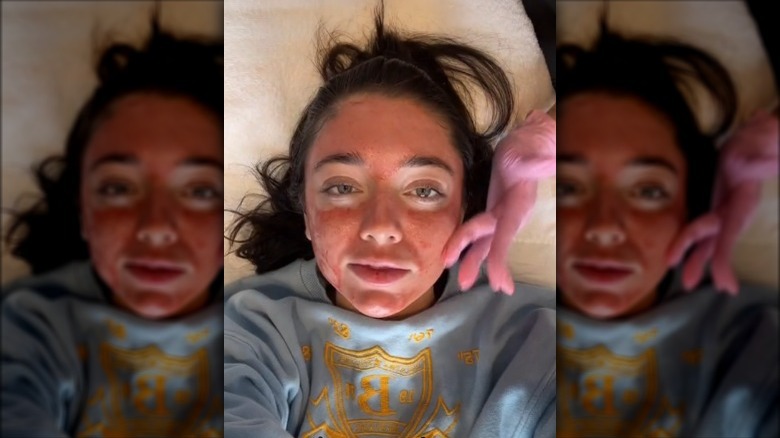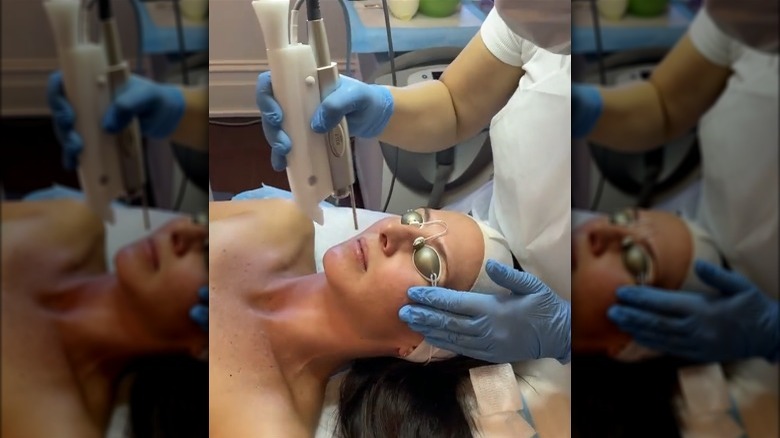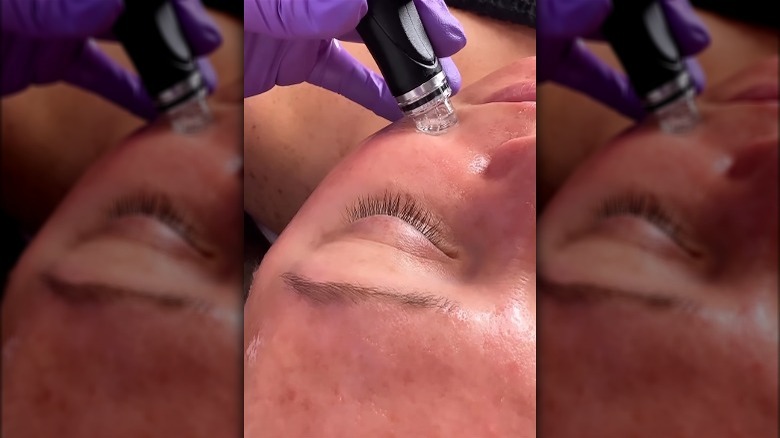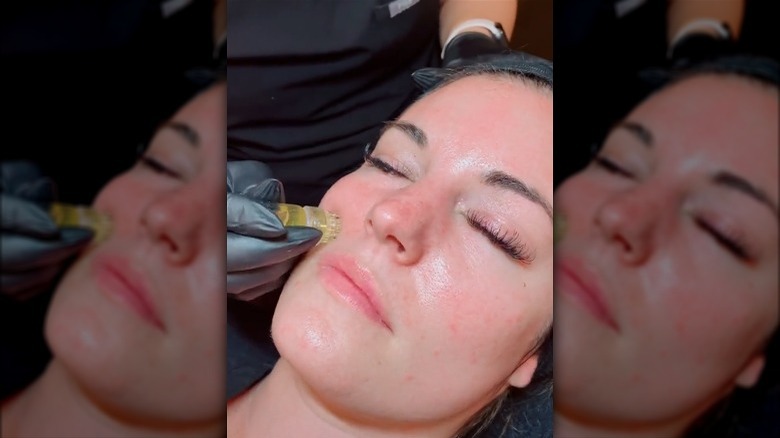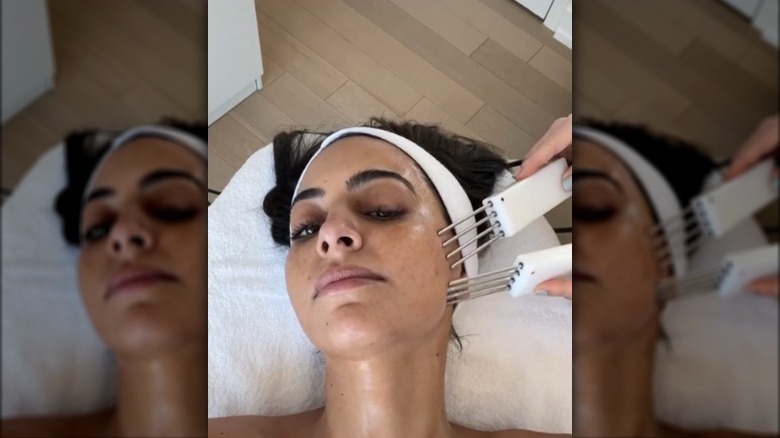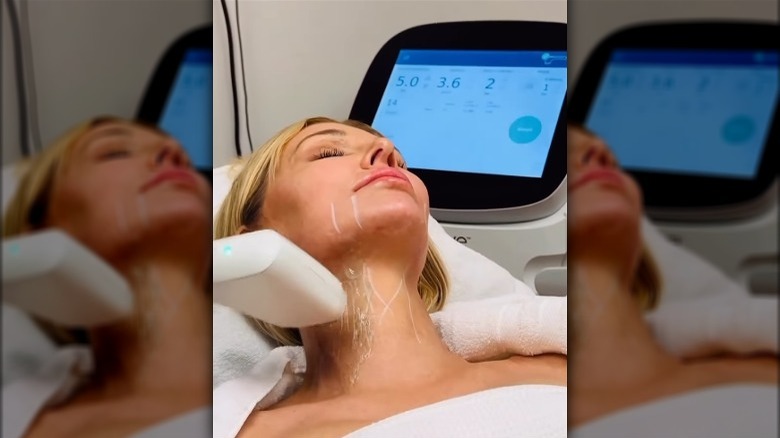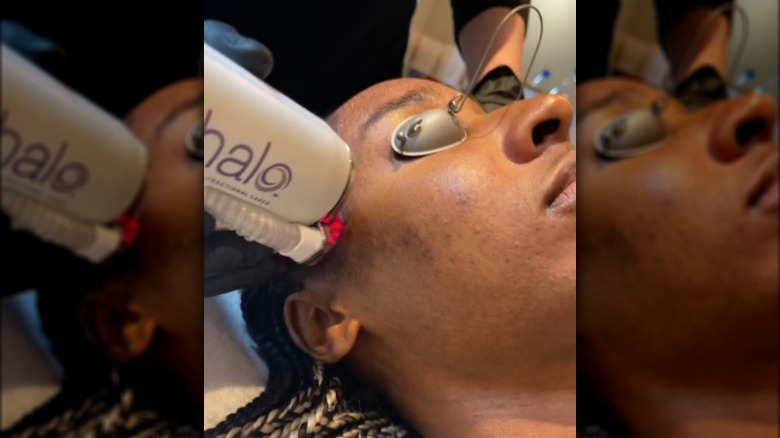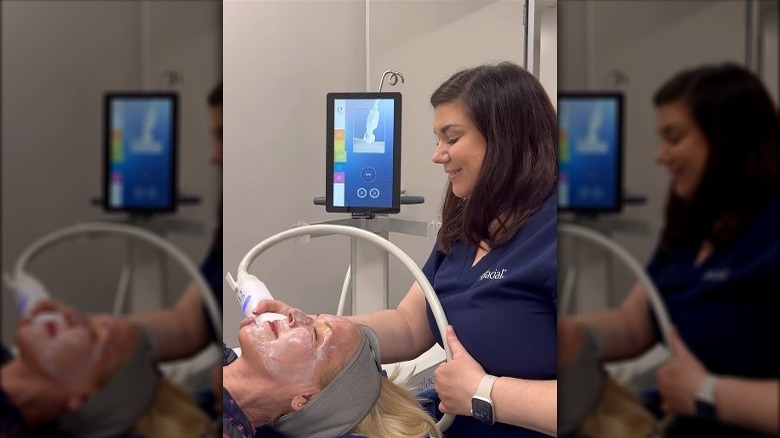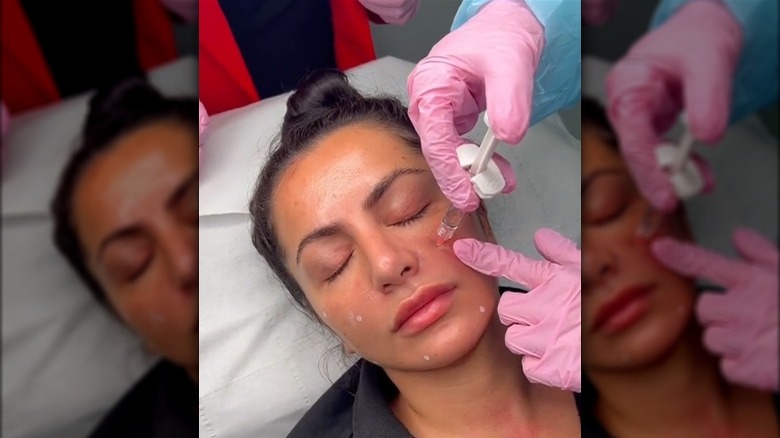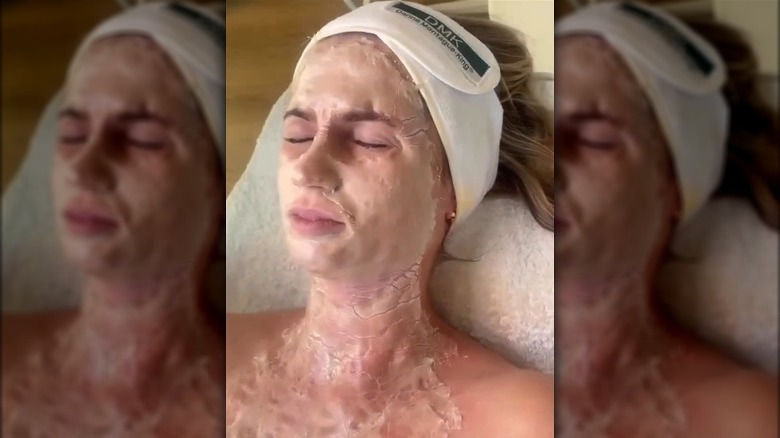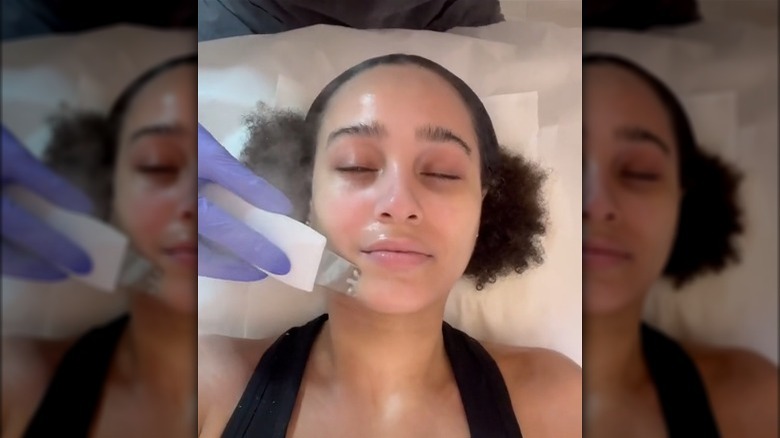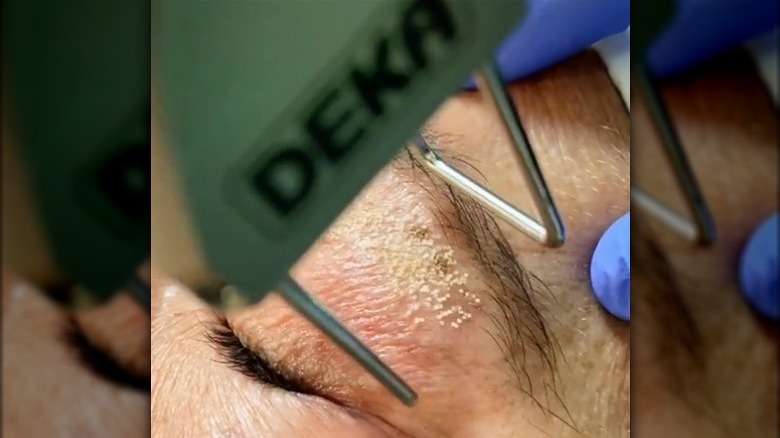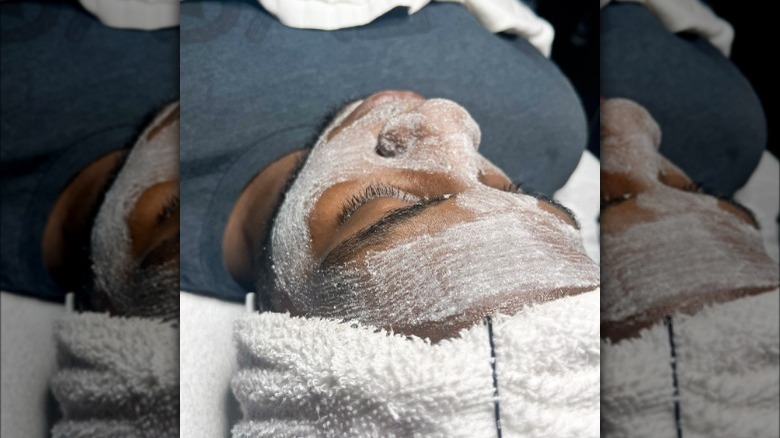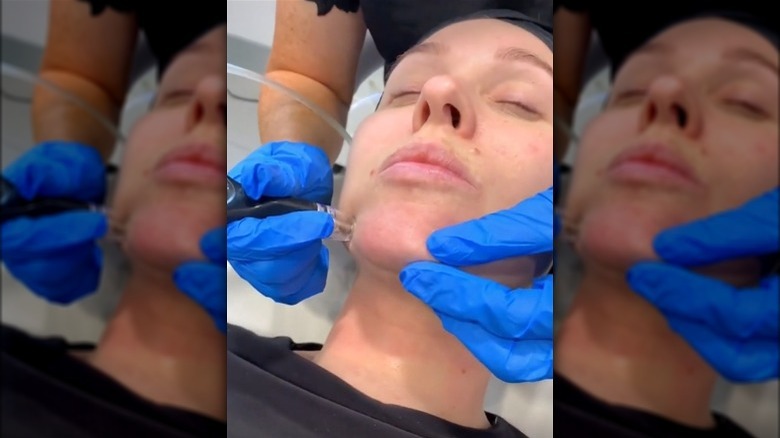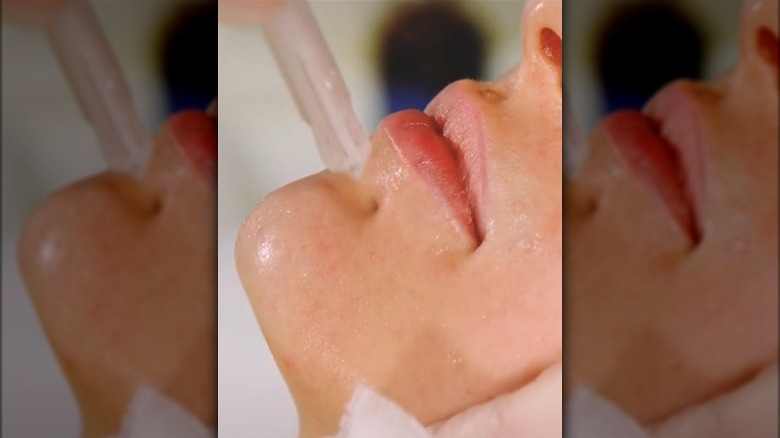24 Skincare Treatments That Require Little To No Downtime
These days, there is no shortage of cosmetic procedures designed to help people maintain a youthful, glowing complexion. From laser resurfacing and chemicals peels to fillers and face lifts, there's an in-office treatment for anyone looking for stronger results beyond their usual skincare routine. However, while a great deal of these treatments are proven to be effective, they're not exactly the most convenient. A typical facelift requires a full two week recovery period, while numerous laser treatments come with at least a week of downtime before the redness and peeling skin subsides. For folks with busy schedules, this is a big no-no.
The good news is that in recent years, there's been an increasing number of skincare treatments on the market that offer just as effective results with pretty much zero downtime involved. We've rounded up some of the very best ones below that will give you that extra confidence boost without forcing you to stay indoors for days. Just remember that any treatment comes with its own risks, and you should always to consult your doctor before undergoing any procedure.
RHA dermal fillers
Unlike many other dermal fillers, Resilient Hyaluronic Acid (RHA) dermal fillers are made from resilient fibers and longer, syntenic hyaluronic acid that mimic our skin's natural hyaluronic acid. That makes the appearance afterward much softer than traditional fillers, with effects lasting for around 15 months. Dermatologist Dr. Ava Shamban told New Beauty that the treatment is particularly suited to those who have lost volume in their face or are self-conscious of their deep lines and wrinkles. "This product is smooth, similar to our own naturally produced [Hylaronic] and adapts well into our tissue," Dr. Shamban shared. "It helps to rebuild some structure and replace volume losses without adding any bulk."
Unlike collagen fillers, which require up to a week of recovery, there is almost no recovery period required after RHA treatment, though many doctors, like Dr. Partington of Partington Plastic Surgery & Laser Center, advise refraining from doing anything too energetic for about 24 hours in order to minimize the chances of bruising. Staying out of the sun for at least 24 hours after the treatment is also recommended.
EmFace
EmFace is a relatively new treatment designed to lift and tone the face without having to undergo any super invasive needle procedures. As Professor Ali Ghanem explained to Glamour U.K., this injection alternative is a device that uses electromagnetic stimulation and radiofrequency technology via an applicator on the forehead and on both cheeks to encourage muscle contractions. That stimulates the body to produce more collagen and elastin, giving the skin a much more youthful appearance while reducing the appearance of fine lines and wrinkles. Usually, four to six treatments are recommended to get the very best results, with each session lasting for around 20 minutes. Per Dr. Anna Availani Cosmetic Surgery, because there's no needles penetrating the skin, there's absolutely no downtime to worry about, meaning you'll be back to work in no time!
If that sounds like something totally different to the procedures you're used to that attempt to achieve the same results, that's probably because it is. Plastic Surgeon Dr. Yael Halaas even described is to Cosmopolitan as being "the only treatment of its kind." No wonder you've probably seen it all over TikTok!
Laser Genesis
Laser Genesis is another needle-free alternative to treat various skin issues in the short term. According to Healthline, the non-invasive procedure warms up the dermis to stimulate collagen production, which, in turn, plumps up the skin to combat fine lines and wrinkles. At the same time, it's working to tighten the blood vessels to reduce redness, and aid with acne prone skin. Simple, right? You won't even have to take too much time out of your day to get it done, either as the treatment can last about 30 minutes, and you should be able to return to your daily activities right after.
Laser Genesis isn't usually a one and done kind of treatment, though, and many doctors recommend multiple treatments to get the best results since the effects typically last less than a month. Board-certified dermatologist specializing in cosmetic dermatology Dr. Jason Emer told Real Self, "You might look at pictures of yourself a year after starting Laser Genesis treatments and think, 'Wow, I look better than I did last year at this time." What an endorsement!
AviClear
Are you an acne sufferer? If so, then you might want to give AviClear a go. This laser skincare treatment consists of three 30-minute, in office treatment sessions. Unlike many other harsher solutions to clearing up often painful acne flare-ups, it doesn't come with any downtime or a recovery period, which means patients can continue on with their day following their sessions to show off their clearing skin.
AviClear is the first and original FDA-cleared energy device for the treatment of all different levels of acne. It works by using lasers to identify and then suppress the sebaceous glands under the skin, which can cause blemishes when dirt gets trapped in them. The beauty of this is it treats acne at the source without the need for topical or oral medications, which can sometimes be too harsh for the skin and come with nasty side effects.
Board-certified nurse practitioner Jennifer Hollander explained to The Zoe Report that many experts suggest getting three treatments every four weeks in order to get the best results you can and wave goodbye to those often painful breakouts
IPL Photo Facial
Love the flash of the camera? Then the IPL Photo Facial could be for you. Contrary to popular belief, IPL, which stands for Intense Pulsed Light, is not a laser treatment, and instead combats skin issues using repeated quick and powerful flashes of light from a special device. This light penetrate the skin's surface and targets pigmentation. Board certified dermatologist Dr. Avnee Shah explained the benefits of the procedure to Haute Living, sharing, "It has the ability to treat the top layer of skin (the epidermis) where we may have issues with color and texture as well as the ability to treat the second layer of skin (the dermis) to encourage collagen stimulation." It's particularly good for those looking to improve the signs of sun damage and broken capillaries, as well as easing rosacea. But it's not suitable for everyone. Dr. Shah shared the best candidates for the treatment are those with fair skin who are looking to combat rosacea or red or brown spots.
One session can take around 30 to 90 minutes to complete and though some people may experience a little redness or swelling immediately after, many people jump right back into their day afterward. It's also perfectly fine to put on some makeup afterword, which could last for between two and five days.
Dermaplaning
One of the least invasive of all the treatments on our list, Dermaplaning is like a really good exfoliating session. It involves using a tiny blade (don't get too scared yet though, it's not as scary as it sounds!) to essentially shave down dead skin cells thus resulting in smoother and brighter looking skin. A specific technique and pressure are applied during the session, which also works to gets rid of dead skin cells.
Medical aesthetician and skin specialist Bianca Estelle is just one of the professionals who swears by the simple yet effective technique, telling Elle, "Dermaplaning can work wonders for the complexion. Not only can it appear brighter, but a build-up of dead skin cells can clog your pores and follicles resulting in breakouts meaning this treatment can aid clearer skin." And when we say there's no downtime to this one, we really mean it. Because there's no invasive element, you can head out the door and right back to your day.
Keep in mind though that, although it's one of the simplest and most non-invasive treatments, it may not be for everyone. If you have Polycystic Ovary Syndrome, hypersensitive skin, or active acne, you may want to sit this one out, as it can affect hair growth. Estelle further explained to Elle that it may not be suitable for those with facial sores because the blade can trigger inflammation and scarring, as well as infection by spreading around bacteria from any sores that haven't healed.
Clear + Brilliant Touch Laser
Used to tackle a multitude of issues related to the skin's appearance, including evening tone and texture, minimizing pores, and increasing firmness, Clear + Brilliant Touch Laser is suitable for all patients who are looking to obtain a more youthful glow. The laser treatment works by focusing the beam on upper layers of damaged skin, which prompts it to regenerate with healthier tissue. Due to its non-invasive nature, it's particularly favorable for those who want results but maybe don't want the commitment of fillers.
Dr. Ava Shamban confirmed to New Beauty that four to six treatments around two or three weeks apart are recommended in order to get the best results. "Each treatment will have cumulative benefits that will be seen starting after the official 'healing' within a week or so following the procedure," she explained. Each treatment session can last anywhere from 10 to 30 minutes, and there's no required downtime period to worry about. In fact, you could even get it done during your lunch break and return to work right after!
BBL Hero
You could blast away bad skin with BBL Hero, aka Broadband Light High Energy Rapid Output. The technology uses a high energy laser to zap away the likes of sun damage, acne, brown spots, redness, rosacea, fine lines, wrinkles, and scarring, while stimulating the collagen production for an all around plumper look to the skin. Speaking to New Beauty about the process, Plastic surgeon Dr. Sheila Nazarian explained, "It contains technology advances which allow for customized delivery of high energy, at high speed — all with cooling that can keep up. The net result: outstanding results in less time, while keeping the patient comfortable." For best results, the procedure is usually done in one or two treatments, though many will see immediate skin improvement within one and two weeks after the treatment.
The treatment can be used by pretty much any adult with any skin tone, but will deliver the best results to those experiencing pigmentation issues. You'll be able to carry on with your day post-treatment as well, because there's no downtime to worry about.
Microneedling
Microneedling is one of the most popular ways to get better looking skin. The process essentially involves having a pen with numerous tiny needles repeatedly penetrate your skin and cause microinjuries. The idea here is that it stimulates your skin's natural healing process, which includes producing collagen. As a result, it offers a number of big benefits, including treating acne scars, improving skin texture, and shrinking large pores, while also plumping up the skin's appearance, according to Healthline.
"New elastin and collagen are stimulated with each treatment. This, in turn, begins to improve the texture, elasticity, and tone to the skin," Master Provider Brandie Girmann explained to Juvly, noting that it can sometimes cause some bleeding as it resurfaces the skin. "It's amazing for fine lines, deep lines, sun damage lines, large pores, skin laxity, stretch marks and more," he added.
Though there's no real downtime, it's recommended you book treatments around two weeks before any big events. Recovery time for the redness to go down and the skin to fully heal can be anything between 24 and 72 hours. It's recommended to complete the microneedling process in three to six sessions spaced every six to eight weeks, though that can vary depending on your skin and how many treatments you've already had.
The Vampire Facial
During the Vampire Facial, blood is removed from the body (usually the patient's arm), separated into plasma and platelets to create platelet-rich plasma (also known as PRP). This is then applied to athe face after a micro needling session to create punctures in the skin. According to Allure, proponents of this spookily named treatment claim that platelet-rich plasma to the skin promotes cell turnover, which causes the body to produce more collagen and elastin.
Though there's no downtime, though board-certified dermatologist Dr. Jordan Carqueville advised to Cosmopolitan that patients should refrain from putting anything too harsh on their skin for the first 48 hours. The overall healing process for the skin could be between 48 and 72 hours for the redness to go down, during which time you need to stay out of the direct sun. No direct sunlight and blood. Now do you see how it got its name?
You may actually have already heard about this one before though, as Kim Kardashian famously underwent the procedure back in 2013 and shared the pretty jarring bloody photos on Instagram.
FRAC3 Skin Rejuvenation
Because of its total lack of recovery period, the Frac3 Skin Rejuvenation treatment has been referred to as the lunchtime facelift or the lunch hour laser – so, it's all in the nickname that you'll be back to work the very same day! This 20 to 30 minute laser procedure diminishes imperfection on the skin by heating to cause micro injuries on already damaged areas of skin. The difference between this and other laser procedures is that the laser here is narrow and focused on the specific areas that need treatment, so it's not as harsh as other areas won't be affected. Unlike other treatments, which require repeat sessions, this can be done as a one-off treatment or in multiple visits depending on what you want and need from your skin. Some of the big benefits include improving the appearance of scaring, smoothing the skin's texture, as well as reducing the appearance of wrinkles, redness, and blemishes. It can also have a tightening effect on the skin by stimulating collagen
Hydrafacials
Hydrafacials can be used to work on a number of different skin issues. Using a Vortex-fusion system, it resurfaces and improves the skin in three stages, focusing on cleansing, exfoliation, extraction, and hydration, while leaving your face glowing by cleaning the pores. "The treatment reduces fine lines and wrinkles, increases firmness, evens tone, texture, and brown spots, as well as reducing enlarged pores," Dr. Anne Guanche told InStyle.
One of our very favorite things about Hydrafacials though is that they can take less than 30 minutes per session (so they're pretty quick if you have a busy schedule!) They can also be customized to your skin depending on the results you're looking for, making them ideal for pretty much everyone, from those to oily, dry, combination skin as well as those with acne or sensitive skin. As for the downtime? There is literally none! You can carry on as normal right after and even put on makeup right after the treatment.
AquaGold Fine Touch
AquaGold Fine Touch is a relatively painless treatment that brightens the skin, reduces fine lines and wrinkles, improves acne scarring, and minimizes the appearance of large pores. Not only can it be used on the face and neck, but it can also be used to improve the appearance of the skin on the décolletage, and hands, too!
But what is it exactly? Well, it combines ingredients like hyaluronic acid, vitamins, and Botox into a single infusion that is injected into the skin via microchannels. The benefit of this treatment is that it is totally customizable, so the mixture of ingredients you get will depend on your skin type and the benefits you'd like to see.
Dr. Pamela Benito described the process of AquaGold during one interview as, "skin rejuvenation with no downtime," because of the way you can get right back into your routine right after. Noting the benefits, she said, "[It] nourishes, heals and rejuvenates the skin giving a more radiant and natural youthful glow." No wonder it's even been tried by Kim Kardashian herself!
Microcurrent facial
Rather than focusing on skin imperfections like many other treatments, a Microcurrent facial is more about sculpting the face and really bringing attention to its contours for a slimmer appearance. "Microcurrent is a great, non-invasive treatment to really tone, tighten, and lift the skin," celebrity aesthetician Shani Darden told The Zoe Report. Each session lasts around an hour and 20 minutes, and, as fellow aesthetician Nerys Rodriguez told Elle, it's almost like getting a workout for your face. She explained that patients will feel a current stimulate their facial muscles, with the current gradually getting stronger depending on your desired results and comfort level.
Some of the benefits include stimulating the production of collagen and elastin, while also decreasing puffiness in the face. Microcurrent facials can be done by almost everyone, but you'll want to be careful if you have any heart issues because of the way it's designed to stimulate the blood. The best part is because it's non-invasive, there's no downtime to worry about, but you're getting instant results!
Sofwave treatment
"Sofwave is a noninvasive tissue tightening and lifting ultrasound device that targets the dermis, which is a layer of the skin that is important for tissue tightening," explained double-board certified facial plastic surgeon Dr. Jason Bloom, to Allure. That means it's ideal for those looking to eliminate some of the sagging and looseness that can develop in their skin over time. The device actually causes small injuries to the skin, which then get repaired and create new collagen, tightening the tissue in your face.
With all that going on, following the procedure, you should gradually notice an improvement in fine lines and wrinkles, while the skin will continue to look tighter and more plump overall for up to a year! The Sofwave procedure is done in increments of 30 seconds on different areas of the skin and the treatment usually lasts between 30 and 40 minutes, while being designed so that it doesn't interrupt your daily routine. "Sometimes patients will leave with a little bit of pinkness. But most people leave with a glow," Dr. Blair Murphy-Rose told Coveteur of the no downtime treatment — which even the likes of former "The Real Housewives of Beverly Hills" star Brandi Glanville has tried out! "Some results are seen in as little as a week but significant collagen generation can take up to 12 weeks. Most patients would only need a single session to see significant improvements," she added.
Sciton HALO laser
Another minimally invasive treatment, Sciton HALO makes use of a hybrid laser system that applies both ablative (which removes the top layer of the epidermis) and non-ablative methods of resurfacing to the skin to stimulate the production of new collagen. It's typically used to combat a number of different skin issues, with some benefits including a reduction in the appearance of wrinkles, tightening of the skin, diminished evidence of sun damage, and increased elasticity.
The downtime you'll need after the procedure can depend on how intense your session was, though most people who have a mild treatment will be able to return to their daily activities the very next day. For the first 24 hours, though, you may notice a little swelling or a burning sensation on the skin, with the results of the treatment becoming apparent between the two and five day mark. Depending on the strength of the session, two treatments may be required to see a big difference, with annual maintenance treatments strongly encouraged.
Glacial Rx
If it's time to hit back at inflammation, Glacial Rx may be the way. This cryoaesthetic treatment uses a special cooling technology to combat skin issues like acne and rosacea. "The treatment uses a precision cooling factor algorithm that's customized to each individual to minimize inflammation and calm the skin. By reducing chronic inflammation, Glacial Rx helps improve the skin's appearance, resulting in reduced redness and discoloration," Dermatologist Dr. Dendy Engelman explained to Cosmopolitan.
The treatment can be customized to your own needs and skin concerns to help you get the results you want. And although we know having something super hot or super cold on your skin may not be the most comfortable feeling ever, it's pretty much pain free and comes with no downtime, as you can resume your normal activities right after. It also claims to be so effective in improving the skin's appearance that most people only need one treatment. However, if your skin issues are particularly stubborn, you may want a follow-up session.
Profhilo
If you're not squeamish about injections and want to achieve plump, glowy skin without a long recovery process, you may want to look into Profhilo. According to Dr. Yusra Clinic, the procedure involves injecting hyaluronic acid into the skin in specific places and has similar effects to Botox, but with less chance of complications (because it doesn't actually freeze your muscles in the same way). Many who have the treatment also feel the results are more natural looking than Botox injections, as the concept involves working towards actually eliminating wrinkles rather than just filling them out.
As for the downtime, there is none here! However, following the procedure, you may see few small bumps where the injection took place, as Get The Gloss reported they could stay for around four to six hours after the procedure, but shouldn't be too noticeable. Dr. Yusra Clinic also recommends staying away from any activities that are too vigorous for the first 24 hours, but you should be able to get back to your day-to-day routine (minus the gym!) right after.
DMK Enzyme Therapy
DMK Enzyme Therapy (also known as DMK Oxygen Therapy) is a special enzyme mask made designed to address numerous skin ailments like pigmentation, acne, and redness, while working to keep the skin smooth and tight. The treatment sees the patients lie down as the mask is applied to their face, which then sets and really works to tighten the skin . Proponents of the treatment claim the enzymes penetrate deep into the skin's layers to open capillaries so blood can pump around the body more freely, resulting in a youthful look. You also get to relax and chill while it all happens!
"The uniform tightening of a renewal mask helps to flush the lymphatic system and promote a true reaction in the plasma-rich platelets in the skin with results that renew, reboot, lift, brighten, and tighten the skin," board-certified oculoplastic and reconstructive surgeon Dr. Kami Parsa told The Zoe Report of the process. According to Face The Future Clinic, though there may be a little soreness are redness after the future, this only lasts for about a day, so you can return to normal activities immediately after.
Oxygen Facial
Fewer blemishes, fewer fine lines and wrinkles, and beautifully hydrated skin are just some of the benefits Healthline reports are on offer when treating yourself to an Oxygen Facial. Per Healthline,
the idea behind this unique spa treatment is that pure oxygen can nourish and rejuvenate skin cells, helping to encourage the circulation of blood around the face.
Because this facial doesn't use any injections, it requires absolutely no downtime. So, how does it work exactly? Well the treatment actually makes use of a high pressured oxygen stream that sprays goodness like hyaluronic acid, vitamins, and anti-oxidants deep into the skin.
The Oxygen Facial is thought to be a particular favorite of a number of celebrities too, with The Skincare Edit claiming the likes of Madonna, Kim Kardashian, Victoria Beckham, and Jessica Biel and Justin Timberlake all reportedly using their own oxygen machines to get Oxygen Facials done at home.
The Madonna Lift
Touted as an alternative to eyelid surgery, The Madonna Lift uses a fractionated CO2 laser treatment to improve the look of delicate skin areas where many people have the majority of wrinkles and fine lines. Its main focus is on tightening the skin around the eye area, which is where so many of us show our age. Say goodbye, crow's feet! The treatment was first pioneered by Dr. Bruce Katz, and, yes, he named it after that Madonna.
While you can opt for a single treatment, Dr. Steven J Pearlman told Surgicare Arts & Aesthetics he recommends getting three treatments every six weeks in order to achieve the best results. The procedure takes only 10 minutes and is relatively painless since a topical numbing cream is often applied before the laser is used. Best of all, since it's not a surgical procedure, there's no need to take off several days of work as there's pretty much no post-procedure downtime required. However, there can be a few side effects. "Patients are red for about a day or two and pink for a few days, but can return to work with cover-up makeup in about three days," Dr. Pearlman explained, noting that how long it can take the skin to heal can depend on the aggressiveness of the laser treatment you receive depending on your skin and the desired results.
Microdermabrasion
Easily one of the most common skincare procedures out there, Microdermabrasion addresses numerous skin issues by removing the top layer of dead and damaged skills with a special exfoliating device. The American Academy of Dermatology Association noted the process is best known for having a brightening and smoothing effect on the skin, while also minimizing the appearance of sun damage, fine lines, and age spots. It's also been known to shrink acne blemishes and pores.
Dermatologist Dr. Janet Allenby is just one medical professional who can't get enough of the simple yet effective treatment, explaining to Real Self, "Microdermabrasion has been used for well over 20 years in my practices, and it still amazes me how quick and nice the skin tone becomes after even a single treatment." Each session lasts around 30 to 40 minutes for just the face (it can also be used on the neck), and there's no recovery period. For best results, Ease Med Spa recommends one microdermabrasion treatment every two months for those who are new to the procedure, though over time, treatments can be spaced out.
Dermalinfusion
Dermalinfusion consists of a three factored treatment that uses a wand to exfoliate, extract, and infuse the skin with special serums. While it all sounds a little similar to Microdermabrasion, Sona Tolani, chief marketing officer at Envy Medical, explained one of the biggest differences to Byrdie. "We aren't using loose crystals and blasting the skin; we're using medical-grade diamond tips [to] abrade the top layer, extract the dirt and debris, and infuse the skin with serum," she shared. Now that sounds fancy!
Another big difference between a Dermalinfusion facial and undergoing microdermabrasion is that you're able to customize the wand to the level of pressure you want during your session, meaning, unlike microdermabrasion, the tip can be softened and used on more sensitive areas like the eyes. The procedure is reportedly relatively painless and takes less than an hour total. Since it's even gentler than Microdermabrasion, most people can resume their day post-treatment without any special aftercare steps. According to Healthline, there are a whole range of skin issues Dermalinfusion can improve, from acne, to eczema, to hyperpigmentation, fine lines, and rosacea.
Jet Peel Facial
Another non-invasive skincare treatment with pretty much no downtime is the Jet Peel Facial. Unlike a traditional facial, which leaves ingredients sitting on the surface, the Jet Peel Facial technique involves using a small pen to penetrate the skin with pressurized air streams, thus allowing for cleansers and serums to get into the skin's deeper layers. Lisa Guidi, Licensed Esthetician and owner of Erase Spa, explained toByrdie that the procedure is comparable to a "lymphatic massage for the face," in that it feels pretty gentle on the skin.
Jet Peel Facial has been found to be useful for treating a number of different skin conditions too. Healthline reported one of the biggest skin issues it's known to tackle is acne, as it's gentle enough for those who suffer breakouts to have regularly. It's also a top exfoliation technique and can combat the many tell-tale signs of aging, like fine lines, wrinkles, and sun spots. "It's good for people that have been traveling a lot, have dehydrated skin, are lacking moisture and elasticity, or just need a skin pick-me-up," Giudi shared.
Following Jet Peel Facial treatment, patients can expect to experience mild facial redness, but for the most part, this subsides after a few hours. Patients aren't required to stay inside, but they should wear a sunscreen if they plan to go outside.
